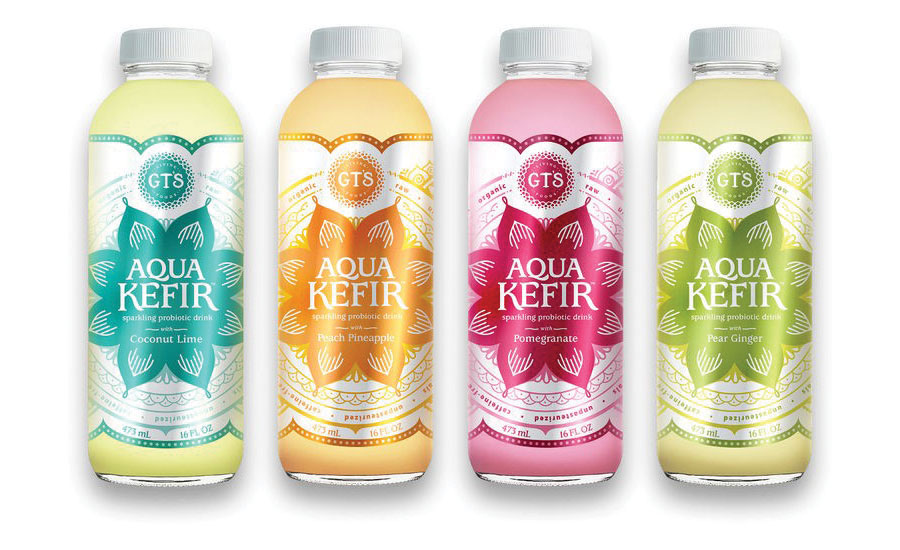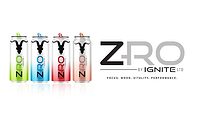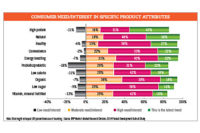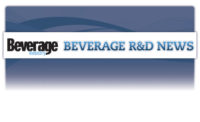New product development addresses numerous functional beverage trends
Experts anticipate increased fortification with digestive-, cognitive-supporting ingredients

Oliva Newton John might have sung “let’s get physical, physical,” but if asked to remake the song to reflect today’s beverage market, the more apt lyrics might be, “let’s get functional, functional.” With beverage-makers increasingly seeking ingredients that deliver a specific function, the functional beverage market is addressing a wide range of product attributes, experts note.
“Health and wellness, hyper-personalization, premiumization and experience culture are driving beverage innovation,” says Holly McHugh, marketing associate for Niles, Ill.-based Imbibe. “Consumers have easy access to information online and can gather personal health data through technologies like FitBit and at-home wellness tests. As a result, consumers are frequently adapting their diets and choosing products that help them achieve personal lifestyle goals.
“Additionally, consumer purchases are more spontaneous than ever, but they are willing to pay more for products that taste good and fulfill a need in-the-moment,” she continues. “Premiumization has played an important role in communicating value and justifying a higher price tag.”
McHugh notes that when it comes to the type of functionality, the beverage market is flush with a diverse set of trends.
“Beverages that deliver key nutrients, energy drinks and digestive health products continue to be popular with consumers,” she says. “Mood-boosting and relaxation beverages are expected to experience significant growth as well in the next few years.”
Caleb Bryant, associate director of food and drink reports for Chicago-based Mintel, also highlights which functionalities are on the rise and what’s declining.
“According to Mintel’s Global New Products Database, functional brain health is the fastest-growing claim in all U.S. beverages, comparing 2015 to 2019,” he says. “Stress/Sleep claims also experienced significant growth. Conversely, bone health claims have declined.”
With so many functional claims on the rise, this has helped further the maturation of the hybrid beverage market.
“The next generation of functional beverages will include ingredient combinations that address multiple need states or several harmonizing ingredients that help consumers fulfill a specific goal,” Imbibe’s McHugh says. “Energy drinks are a popular channel for incorporating functional ingredients beyond caffeine to address multiple needs in one beverage. Over the last year, energy drinks enhanced with popular sports nutrition ingredients like creatine, electrolytes, and branch-chained amino acids (BCAAs) have gained ample shelf space at specialty, convenience and grocery stores.”
Through a variety of ingredient sources, McHugh anticipates that the functional beverage market will only continue to grow in the year ahead.
“In order to fulfill varying consumer demands, brands will offer more options than ever through functional beverages that address specific need states like energy, cognitive performance, gut health and beauty,” she says. “Additionally, beverage brands have been trying to stay on top of industry trends by incorporating novel ingredients like adaptogens, cannabidiol (CBD) and collagen into products. While these types of ingredients will continue to be popular in functional beverages, expect an abundance of products that go ‘back to the basics’ with familiar and essential vitamins and minerals. Brands will aim to incorporate key nutrients that improve overall health via superfoods and fortification.”
Yet, prognosticating the next trend that evolves from a fad to a staple beverage segment still remains a challenge. Recognizing the complexity of new product development, McHugh details that streamlining this process is not just about understanding consumers’ needs but also how a company wants to approach the development process.
“Consumer needs are a moving target, which has made it very hard for brands to pinpoint what will be successful and experience growth for years to come,” she says. “Rapid product development can be a challenge, especially for larger brands whose innovation pipeline often takes longer than smaller brands. We see a lot of larger brands investing in smaller brands or creating their own beverage incubators but having a partner that can speed up the product development process can be less expensive and still get products to the market faster.”
Ingredients of choice
As beverage-makers turn to trusted sources to help them formulate the next great innovation, the list from which these formulators can choose only continues to grow.
An emerging market 20-plus years ago, the energy-enhancing beverage category has not only matured but also has evolved in terms of the types of ingredients that are in today’s energy drinks.
“Caffeine is still king when it comes to energy claims but many companies are calling out their use of L-theanine due to the amino acid’s sustained energy benefits and purpose cognitive benefits,” Mintel’s Bryant says. “Consumers want the boost from energy drinks but not the associated crash, which is why there has been an uptick in the use of L-theanine in beverages.”
Energy functionality also has been an attribute association for cognitive health; however, cognitive health is more than just alertness. Consumers seeking attributes such as memory, mood and even processing speed have resulted in beverage-makers turning to an emerging set of ingredients to fulfill these demands.
“There are a wide range of ingredients — often referred to as nootropics — that are suggested to improve memory, creativity, motivation and clarity,” Imbibe’s McHugh explains. “Antioxidant-rich botanicals like green tea and yerba mate, and adaptogenic herbs deep-rooted in ancient traditions like holy basil, ginseng and schisandra are popular ingredients in cognitive health beverages because they are suggested to boost energy, vitality and mood.
“Many cognitive health beverage supplements include amino acids like acetyl-L-carnitine, L-theanine and L-tyrosine for a mental boost among other benefits,” she continues. “Amino acids play an important role in brain health by stimulating production of neurotransmitters that affect mood, memory and focus.”
Mintel’s Bryant adds that medium-chain triglycerides (MCTs) are being used as an ingredient source for cognitive health, and he further expands on the benefits of nootropics.
“MCT oil is used in many beverages that are said to support cognitive health,” he says. “Nootropics are trending in both food and beverage applications. Nootropics are ingredients said to increase cognitive performance and [are] quickly gaining popularity.”
In terms of fortification, digestive health is another trend proliferating throughout the beverage market. “Pre- and postbiotics are now widespread thanks to overall consumer interest in digestive health,” Bryant says. “Twenty-four percent of consumers say they eat or drink products that contain probiotics.”
Imbibe’s McHugh, however, notes that part of the growth of products that support healthy digestion stems from a growing awareness.
“Awareness about the advantages of a healthy microbiome for overall health has increased significantly over the last decade,” she explains. “Since prebiotics and probiotics both play an important role in maintaining a healthy gut, expect launches of synbiotic beverages (i.e., have prebiotics and probiotics) to become mainstream. We also expect to see an uptick in the use of inulin, not only because it may impart sweetness in products, but also for the potential for a fiber claim. Fiber also plays a critical role in digestive health and assists with satiety and weight management.”
However, in the constant on-the-go hustle of many consumers’ lives, a growing sector is turning to relaxation fortification in order to unwind. With the 2018 Farm Bill opening up opportunities for hemp ingredients in topicals, many experts expect this category to bode well for foods and beverages, particularly in states that have legalized its usage in consumables.
“CBD is one of the trendiest ingredients in the beverage industry as some believe it promotes relaxation,” Mintel’s Bryant says. “However, the legality of CBD in food and drinks remains a gray zone. Adaptogens are being used in more foods and drinks as they are said to protect the body from stressors.”
Imbibe’s McHugh echoes similar sentiments: “Familiar ingredients like chamomile, green tea and lavender as well as novel ingredients like adaptogens and cannabidiol (CBD) are popular ingredients in beverages that improve mood and relaxation,” she says. BI
Looking for a reprint of this article?
From high-res PDFs to custom plaques, order your copy today!






